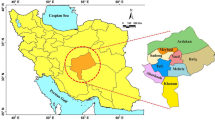Abstract
Four-hundred-sixty-eightFusarium andFusarium-like isolates were obtained from crowns and subcrown internodes of winter wheat grown in Erzurum, Turkey. Of these isolates, 34.8% wereFusarium acuminatum, 32.3% wereF. equiseti, 16.9% wereF. oxysporum, 15.0% wereMicrodochium nivale (formerlyFusarium nivale), 0.6% wereF. tabacinum and 0.4% wereF. solani. In pathogenicity tests on wheat, the highest disease severity was caused by isolates ofM. nivale, whereas isolates ofF. acuminatum, F. equiseti, F. oxysporum andF. solani were slightly virulent; isolates ofF. tabacinum were nonpathogenic. This is the first report ofM. nivale andF. tabacinum from wheat in Turkey.
Similar content being viewed by others
References
Anon. (2001) Agricultural Structure (Production, Price, Value) 1999. State Institute of Statistics, Prime Ministry, Republic of Turkey, Ankara, Turkey.
Demirci, E. (1998)Rhizoctonia species and anastomosis groups isolated from barley and wheat in Erzurum, Turkey.Plant Pathol. 47:10–15.
Eken, C. and Demirci E. (1998) The distribution, cultural characteristics, and pathogenicity ofDrechslera sorokiniana in wheat and barley fields in Erzurum region.Turk. J. Agric. For. 22:175–180.
Fedel-Moen, R. and Harris, J.R. (1987) Stratified distribution ofFusarium andBipolaris on wheat and barley with dryland root rot in south Australia.Plant Pathol. 36:447–454.
Fouly, H.M., Pedersen, W.L., Wilkinson, H.T. and Abd El-Kader, M.M. (1996) Wheat root rotting fungi in the “old” and “new” agricultural lands of Egypt.Plant Dis. 80:1298–1300.
Gerlach, W. and Nirenberg, H. (1982) The GenusFusarium, a Pictorial Atlas. Biologische Bundesanstalt Land- und Forstwirtschaft Inst. Mikrobiologie, Berlin-Dahlem, Germany.
Muratçavuşoğlu, N. and Hancıoğlu, Ö. (1995) Researches on the determination ofFusarium spp. causing root and crown rot diseases in wheat fields of Ankara province.7th Turkish Phytopathological Congr. (Adana, Turkey), pp. 174–177 (Turkish, with English abstract).
Parry, D.W. (1990) The incidence ofFusarium spp. in stem bases of selected crops of winter wheat in the Midlands, UK.Plant Pathol. 39:619–622.
Pettitt, T.R., Parry, D.W. and Polley, R.W. (1996) Effect of temperature on the incidence of nodal foot rot symptoms in winter wheat crops in England and Wales caused byFusarium culmorum andMicrodochium nivale.Agric. For. Meteor. 79:233–242.
Smiley, R.W. and Patterson, L.M. (1996) Pathogenic fungi associated withFusarium foot rot of winter wheat in the Semiarid Pacific Northwest.Plant Dis. 80:944–949.
Soran, H. and Damgacı, E. (1980) Researches on the determination of fungal agents causing root and crown rot diseases in wheat fields of Ankara province. Publ. No. B-80-1, Çukurova University, Adana, Turkey (Turkish, with English abstract).
Tinline, R.D. (1986) Agronomic practices and common root rot in spring wheat: Effect of depth and density of seeding on disease.Can. J. Pl. Pathol. 8:429–435.
Author information
Authors and Affiliations
Corresponding author
Additional information
http://www.phytoparasitica.org posting Jan. 29, 2003.
Rights and permissions
About this article
Cite this article
Demirci, E., Dane, E. Identification and pathogenicity ofFusarium spp. from stem bases of winter wheat in Erzurum, Turkey. Phytoparasitica 31, 170–173 (2003). https://doi.org/10.1007/BF02980787
Received:
Revised:
Issue Date:
DOI: https://doi.org/10.1007/BF02980787




